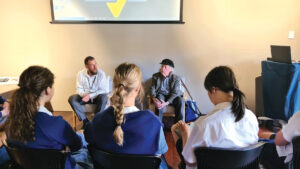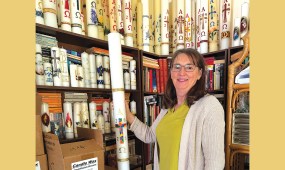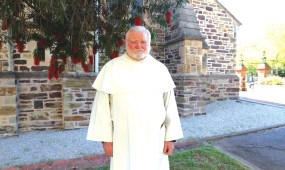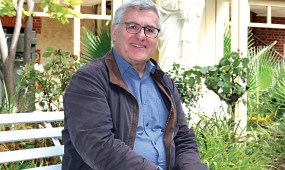Milestone for Holocaust survivor
People
Artist and Holocaust survivor Andrew Steiner OAM will celebrate his 90th birthday this month.

Andrew has been sharing his story of survival with South Australian school students for more than 30 years and was the driving force behind establishing a Holocaust museum in Adelaide.
He was born Jozsef Endre Steiner in Budapest on June 12 1933 into a patriotic Jewish family who had lived in Hungary for generations. He was just six when the war began and 11 when it finished, living in constant fear as people around him were killed and once-friendly neighbours turned hostile. Andrew personally experienced many horrors as a child growing up in Budapest during World War II.
Advertisement
From the beginning of World War II, Hungary’s government allied with Germany, which occupied Hungary in March 1944. Andrew recalls seeing Nazi troops march past his home and his young Hungarian neighbour point at Andrew and shout that he was a ‘dirty Jew’.
In April 1944, each member of Andrew’s family was forced to wear a yellow Star of David, and their home was turned into a Yellow Star House (a network of compulsory residences for Jewish people in Budapest) shared with three other families. Andrew saw his adult family members taken away to labour camps or units attached to the military. Andrew, his sister, Judith, and five cousins remained in their Yellow Star House under the care of their elderly aunt Sarah until they were evicted as part of the deportation process.
At this time, 11-year-old Andrew and 13-year-old Judith did not know the whereabouts of their parents. Sensing danger closing in, their aunt instructed them to remove their yellow stars and take a tram across Budapest to a newly established International Red Cross children’s shelter. For Jews, removal of the yellow star and using public transport was punishable by death. During this perilous journey, Andrew saw columns of Jews being marched towards deportation centres. With directions from a local policeman, the two children arrived safely at the Red Cross refuge.

Andrew Steiner sharing his testimony with visiting students from St Michael’s College.
In December 1944, Andrew’s mother Margit emerged from hiding with false identity papers. She took them to a hillside villa belonging to Andrew’s godfather where the caretaker-gardener allowed them to stay, despite the danger to himself for sheltering Jews. Survival in hiding during the siege meant constant foraging for food and fuel for warmth. After liberation by the Soviet Army, they were reunited with Andrew’s father. Twelve members of Andrew’s extended family perished in the Holocaust.
Advertisement
In 1948, the Steiner family made their new home in Adelaide. Andrew’s first job at 15 was at GR Wills Industrial Glove factory, alongside his mother and sister. In 1950 the family set up their Triumph Leather Goods factory, which in the 1970s became Flinders Ranger Camping Gear, producing high quality camping equipment. Andrew went on to work in the theatre, then took up woodcarving in 1973, developing a successful career as a sculptor and stained-glass artist.
Optimism, hope and love are major themes of Andrew’s art. He is past president of SA Royal Society of Arts. Since 1990, Andrew has provided education about the Holocaust to secondary and tertiary students. Andrew was a finalist in the 2010 Australian Human Rights Awards and was awarded the Order of Australia in 2017 for his service to visual arts and community history.
The establishment of the Adelaide Holocaust Museum and Andrew Steiner Education Centre (AHMSEC) in 2020 is the culmination of Andrew’s life work towards a fairer, more just and compassionate world.
“One of the important lessons I learnt is never to hate because it doesn’t achieve anything at all,” Andrew said.
“The need to commemorate and learn from the greatest tragedy of mankind is essential.
“I was inspired to establish the museum to be a centre for compassion, a beacon of light pointing the way against darkness using education as the tool to achieve a fairer, more just and kinder world.”
Andrew continues to share his story of survival and experiences as part of the museum’s education program.
“Prejudice and antisemitism are once again being normalised across the globe and right here in South Australia, reflecting the need for the education of future generations about the Holocaust to create a better world for all,” said Tamas Lorincz, Museum Education coordinator.
“You can hear a pin drop in the education centre as Andrew recalls the most traumatic experiences of his childhood and describes how he managed to heal the scars of his experiences with love, compassion and creativity.
“He reminds students that by listening to his testimony they become custodians of his story and the ambassadors of making the world a safer, fairer and compassionate place for all.”
For information about AHMSEC and its education program visit ahmsec.org.au





